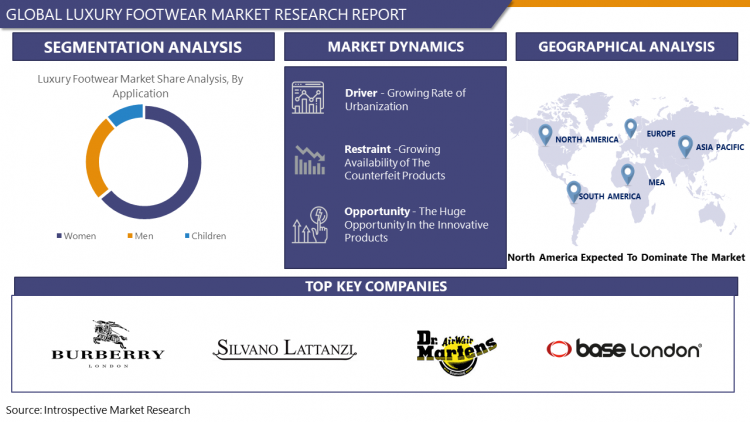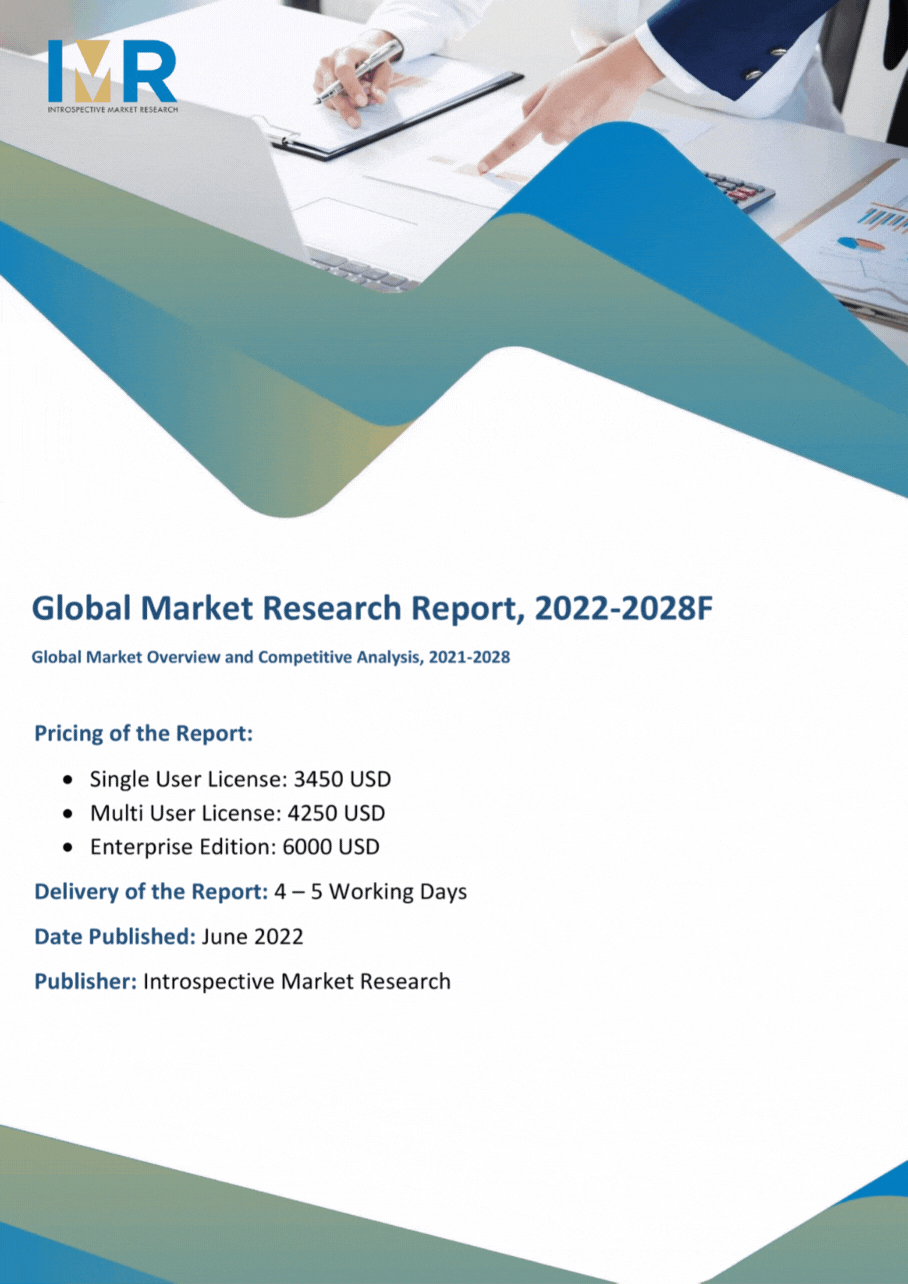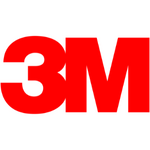Global Luxury Footwear Market Overview
The Global Luxury Footwear Market size is expected to grow from USD 33.52 billion in 2022 to USD 59.78 billion by 2030, at a CAGR of 7.5% during the forecast period (2023-2030).
Luxury footwear is one of the types of the luxury products that are generally associated with the wealthy or affluent. The luxury footwear products include athletic footwear, leather footwear, sneakers, textile footwear, shoes, sandals, and other product types. Beauty, rarity, higher prices, premium quality, aesthetics, symbolism, and extraordinariness are the most common qualities of luxury footwear. The popularity of luxury footwear is increased lately in developed and also developing countries. This is owing to the launching of new footwear by major players in a variety of designs. For instance, in September 2020, Adizero Adios Pro is the new, next standard of professional running footwear specially made for athletes introduced by Adidas. Thus, the growing innovation in the designs of luxury footwear and high individual net worth fuelling the growth of the luxury footwear market.

Market Dynamics And Factors For Luxury Footwear Market
Drivers:
The Growing Rate of Urbanization
In recent years increasing the urban population is the major factor that provides growth for the luxury footwear market. Urban society impacts the way and the standard the people live. In urban society, peoples have to change lifestyles, have high disposable income, and have a high corporate culture, thus people are largely interested to purchase luxury goods. The following chart shows the population of urban areas worldwide by the cities in 2020.

Thus, due to the growing population in urban areas, the demand for luxury footwear is increased. Additionally, in developed countries rising the influx of multinational companies, the consumer culture of costly and luxury footwear has been popularized. Owing to growing internet penetration in urban areas the growing online sales of various products. Online sales offer the facility the work from home. Due to hectic lifestyles and high technical knowledge people buy products online. Luxury footwears are available on various online platforms in different types of designs and presents discount on purchase. Therefore, the demand for luxury footwear is increased which propels the growth of the market.
Restraints:
Growing Availability of The Counterfeit Products
In developed and developing countries growing the availability of counterfeit goods in retail footwear and volatile economic conditions is the key that hampers the growth of the luxury footwear market. Counterfeit goods include a trademark or logo that is identical to the trademark of another. Moreover, the fluctuation in the currency and limited brand outlets among the emerging region also decrease the demand for luxury footwear that factors can be responsible for restricting the growth of the Luxury footwear market.
Opportunity:
The Huge Opportunity In the Innovative Products
The growing number of the launching of new products provides a lucrative opportunity for the luxury footwear market during the forecast year. Several manufacturing industries are focused on the research and development of new luxury footwear. For instance, a Germany-based company, Adidas, a designer, and producer of apparel, luxury footwear, sports equipment, and accessories developed the plant-based leather material in 2020. This material is made from mycelium which is part of the fungus. Additionally, in the same year, the company developed 15 million pairs of shoes. These shoes are made from recycled plastic waste collected from beaches and coastal. Thus the growing research and development activity in the designing of footwear will provide a remunerative opportunity for the luxury footwear market in the forecast period.
Segmentation Analysis Of Luxury Footwear Market
By Product Type, the formal shoe is expected to have maximum market growth in the luxury footwear market. The formal shoe is one of the parts of professionalism in the workplace specifically in the corporate and fashion industries. In the past few years, more peoples give preference to working in the corporate sector. Thus, the number of corporate sectors is growing. According to Statista, in 2021 there were 333.34 million companies present in the world. Hence increasing the demand for the luxury formal shoe. The popularity of formal shoes in the fashion industry is also rising owing to their offering elegance, attractive look, and unique design. It is used on various occasions consisting of a party, concerts, and other public gatherings. Moreover, more people have a growing interest to work in the fashion industry. Henceforth, the maximum sale of the formal shoe in the luxury footwear market.
By End-Users, women are projected to have the highest market growth in the luxury footwear market. Women as compared to men are more fascinated by shopping. They like to live in a standard and modern way. They invest more in the purchase of luxury products including luxury footwear. Luxury footwear is more adopted in the fashion industries and in these industries, the women population is high. Thus, the demand for luxury footwear is increasing. Additionally, the rising population of women around the world. For instance, Statista stated that about 3.85 billion women population in 2020. Henceforth, with rising women population increases the demand for luxury footwear that support the growth of the market over the forecast year.
By Distribution Channels, the online segment is expected to have maximum market growth in the luxury footwear market. In this new generation growing the trend of the purchase goods via online mode. Statista stated that in 2021 more than 2.14 billion people in the world purchase goods or services online. There are various reasons to purchase the product online such as free delivery, coupons, discounts, easy return policy, easy and quick online checkout policies, loyalty points, next-day delivery, knowing the product is environmentally friendly, and the flexibility of the payment mode. Because of these benefits peoples prefers online platform for shopping. Moreover, an increasing number of online platforms for shopping and growing internet penetration in the world. After the covid-19, most people changed their way of shopping. They prefer online platforms over offline ones. Thus, online channels have the maximum market share in the distribution of the luxury footwear market.
Regional Analysis Of Luxury Footwear Market
North America is the dominating region in the luxury footwear market owing to people in this region being more fascinated to purchase modern goods. North America is a well-developed and financially strong region. Thus, they can easily purchase luxury goods. Peoples in this region prefer the modern lifestyle. Additionally, the corporate sectors and fashion industries in this region are rapidly growing. Thus, the demand for luxury footwear in this region. Moreover, the high proliferation of smart devices and high internet penetration that increasing the online platforms for shopping. So, people in this region purchase goods online including luxury footwear. In addition to these, a growing number of the manufacturing industries of footwear in this region develop a huge potential for growth of the North American region in the luxury footwear market.
Europe is the second-dominated region in the luxury footwear market. Europe is a well-developed country and people in this region have disposable income. They are more interested in purchasing luxury goods and having a high capacity to spend on luxury footwear. Additionally, In this region high number of corporate sectors that necessary for employees to wear luxury footwear as a part of professionalism. European likes to live modern lifestyles. Also, the Fashion industry in this region is increased that increasing the demand for luxury footwear. The manufacturers of footwear continuously engaged in the production of newly designed footwear to meet the likes and needs of the consumer. Thus, the market for luxury footwear in Europe is rapidly growing.
Asia Pacific have significant growth in the luxury footwear market. India is the world's second-largest footwear producer, trailing only China. Luxury footwear includes leather footwear. The Indian footwear industry is made up of the leather and non-leather segments, which are driven by a strong domestic market. According to Invest India's report on the 'Non-leather footwear Industry in India,' the sector is expected to grow eightfold by 2030. Due to shifting consumer preferences, 86% of global footwear consumption is now non-leather by volume, and India is following suit. Leather footwear, on the other hand, remains a significant part of the industry and a major export category for India. The United Kingdom is a major export destination for Indian leather footwear. Moreover, with rising disposable income and the emergence of fashion-conscious and discerning consumers, the Indian shoe and footwear market is poised to grow by double digits in the coming years. The shoe industry, as a labor-intensive industry, also provides unique 'social' opportunities, with the potential to create more than 200,000 jobs in the coming years. Thus, Asia Pacific is fastly growing in the luxury footwear market.
Covid-19 Impact Analysis On Luxury Footwear Market
COVID-19 began in Wuhan (China) in December 2019 and has since rapidly grown around the globe. In terms of confirmed cases and reported deaths, the US, India, Brazil, Russia, France, the UK, Turkey, Italy, and Spain are among the countries that have been most severely impacted. Because of the lockdowns, travel restrictions, and business closures, COVID-19 has had an impact on the businesses and industries of numerous nations. Owing to the shortage of raw material supply, and lack of manpower, the consumer goods industry faced unprecedented challenges. The manufacturing industries of luxury footwear stopped their manufacturing process during the pandemic. But the e-commerce platforms help to increase the sale of luxury footwear. With COVID-19 various people suffering from financial crises thus, luxury footwear demand is decreased. In this way, the market for luxury footwear has had steady growth during the pandemic.
Top Key Players Covered In Luxury Footwear Market
- Chanel S.A.(France)
- Burberry (UK)
- Silvano Lattanzi(Italy)
- Prada S.p.A (Italy)
- A.Testoni (Italy)
- Dr. Martens (UK)
- Base London (UK)
- John Lobb Bootmaker (UK)
- Salvatore Ferragamo (Italy)
- Lottusse – Mallorca (Baleares)
- LVMH (France)
- Adidas AG(India), and other major players.
Key Industry Development In The Luxury Footwear Market
In June 2021, a China-based international luxury fashion group, Fosun Fashion Group, acquired an Italy-based manufacturer of luxury footwear, Sergio Rossi S.p.A. from Absolute Luxury Holding S.r.l. for an undisclosed amount. The acquisition aimed to expand the portfolio.
In June 2021, LV Squad sneaker and LV Sunset mule footwear commercials were launched by Louis Vuitton with online sensations Emma Chamberlain and Charli D'Amelio. The footwear styles are now available at all of the brand's retail locations and online retailers.
|
Global Luxury Footwear Market |
|||
|
Base Year: |
2022 |
Forecast Period: |
2023-2030 |
|
Historical Data : |
2017 to 2022 |
Market Size in 2022: |
USD 33.52 Bn. |
|
Forecast Period 2022-28 CAGR: |
7.5% |
Market Size in 2030: |
USD 59.78 Bn. |
|
Segments Covered: |
By Product Type |
|
|
|
By End-Users |
|
||
|
By Distribution Channels |
|
||
|
By Region |
|
||
|
Key Market Drivers: |
|
||
|
Key Market Restraints: |
|
||
|
Key Opportunities: |
|
||
|
Companies Covered in the report: |
|
||
Chapter 1: Introduction
1.1 Research Objectives
1.2 Research Methodology
1.3 Research Process
1.4 Scope and Coverage
1.4.1 Market Definition
1.4.2 Key Questions Answered
1.5 Market Segmentation
Chapter 2:Executive Summary
Chapter 3:Growth Opportunities By Segment
3.1 By Product Type
3.2 By End-User
3.3 By Distribution Channel
Chapter 4: Market Landscape
4.1 Porter's Five Forces Analysis
4.1.1 Bargaining Power of Supplier
4.1.2 Threat of New Entrants
4.1.3 Threat of Substitutes
4.1.4 Competitive Rivalry
4.1.5 Bargaining Power Among Buyers
4.2 Industry Value Chain Analysis
4.3 Market Dynamics
4.3.1 Drivers
4.3.2 Restraints
4.3.3 Opportunities
4.5.4 Challenges
4.4 Pestle Analysis
4.5 Technological Roadmap
4.6 Regulatory Landscape
4.7 SWOT Analysis
4.8 Price Trend Analysis
4.9 Patent Analysis
4.10 Analysis of the Impact of Covid-19
4.10.1 Impact on the Overall Market
4.10.2 Impact on the Supply Chain
4.10.3 Impact on the Key Manufacturers
4.10.4 Impact on the Pricing
Chapter 5: Luxury Footwear Market by Product Type
5.1 Luxury Footwear Market Overview Snapshot and Growth Engine
5.2 Luxury Footwear Market Overview
5.3 Formal Shoes
5.3.1 Introduction and Market Overview
5.3.2 Historic and Forecasted Market Size (2016-2028F)
5.3.3 Key Market Trends, Growth Factors and Opportunities
5.3.4 Formal Shoes: Geographic Segmentation
5.4 Casual Shoes
5.4.1 Introduction and Market Overview
5.4.2 Historic and Forecasted Market Size (2016-2028F)
5.4.3 Key Market Trends, Growth Factors and Opportunities
5.4.4 Casual Shoes: Geographic Segmentation
Chapter 6: Luxury Footwear Market by End-User
6.1 Luxury Footwear Market Overview Snapshot and Growth Engine
6.2 Luxury Footwear Market Overview
6.3 Men
6.3.1 Introduction and Market Overview
6.3.2 Historic and Forecasted Market Size (2016-2028F)
6.3.3 Key Market Trends, Growth Factors and Opportunities
6.3.4 Men: Geographic Segmentation
6.4 Women
6.4.1 Introduction and Market Overview
6.4.2 Historic and Forecasted Market Size (2016-2028F)
6.4.3 Key Market Trends, Growth Factors and Opportunities
6.4.4 Women: Geographic Segmentation
6.5 Children
6.5.1 Introduction and Market Overview
6.5.2 Historic and Forecasted Market Size (2016-2028F)
6.5.3 Key Market Trends, Growth Factors and Opportunities
6.5.4 Children: Geographic Segmentation
Chapter 7: Luxury Footwear Market by Distribution Channel
7.1 Luxury Footwear Market Overview Snapshot and Growth Engine
7.2 Luxury Footwear Market Overview
7.3 Online
7.3.1 Introduction and Market Overview
7.3.2 Historic and Forecasted Market Size (2016-2028F)
7.3.3 Key Market Trends, Growth Factors and Opportunities
7.3.4 Online: Geographic Segmentation
7.4 Offline
7.4.1 Introduction and Market Overview
7.4.2 Historic and Forecasted Market Size (2016-2028F)
7.4.3 Key Market Trends, Growth Factors and Opportunities
7.4.4 Offline: Geographic Segmentation
Chapter 8: Company Profiles and Competitive Analysis
8.1 Competitive Landscape
8.1.1 Competitive Positioning
8.1.2 Luxury Footwear Sales and Market Share By Players
8.1.3 Industry BCG Matrix
8.1.4 Heat Map Analysis
8.1.5 Luxury Footwear Industry Concentration Ratio (CR5 and HHI)
8.1.6 Top 5 Luxury Footwear Players Market Share
8.1.7 Mergers and Acquisitions
8.1.8 Business Strategies By Top Players
8.2 CHANEL S.A.
8.2.1 Company Overview
8.2.2 Key Executives
8.2.3 Company Snapshot
8.2.4 Operating Business Segments
8.2.5 Product Portfolio
8.2.6 Business Performance
8.2.7 Key Strategic Moves and Recent Developments
8.2.8 SWOT Analysis
8.3 BURBERRY
8.4 SILVANO LATTANZI
8.5 PRADA S.P.A
8.6 A.TESTONI
8.7 DR. MARTENS
8.8 BASE LONDON
8.9 JOHN LOBB BOOTMAKER
8.10 SALVATORE FERRAGAMO
8.11 LOTTUSSE – MALLORCA
8.12 LVMH
8.13 ADIDAS AG
8.14 OTHER MAJOR PLAYERS
Chapter 9: Global Luxury Footwear Market Analysis, Insights and Forecast, 2016-2028
9.1 Market Overview
9.2 Historic and Forecasted Market Size By Product Type
9.2.1 Formal Shoes
9.2.2 Casual Shoes
9.3 Historic and Forecasted Market Size By End-User
9.3.1 Men
9.3.2 Women
9.3.3 Children
9.4 Historic and Forecasted Market Size By Distribution Channel
9.4.1 Online
9.4.2 Offline
Chapter 10: North America Luxury Footwear Market Analysis, Insights and Forecast, 2016-2028
10.1 Key Market Trends, Growth Factors and Opportunities
10.2 Impact of Covid-19
10.3 Key Players
10.4 Key Market Trends, Growth Factors and Opportunities
10.4 Historic and Forecasted Market Size By Product Type
10.4.1 Formal Shoes
10.4.2 Casual Shoes
10.5 Historic and Forecasted Market Size By End-User
10.5.1 Men
10.5.2 Women
10.5.3 Children
10.6 Historic and Forecasted Market Size By Distribution Channel
10.6.1 Online
10.6.2 Offline
10.7 Historic and Forecast Market Size by Country
10.7.1 U.S.
10.7.2 Canada
10.7.3 Mexico
Chapter 11: Europe Luxury Footwear Market Analysis, Insights and Forecast, 2016-2028
11.1 Key Market Trends, Growth Factors and Opportunities
11.2 Impact of Covid-19
11.3 Key Players
11.4 Key Market Trends, Growth Factors and Opportunities
11.4 Historic and Forecasted Market Size By Product Type
11.4.1 Formal Shoes
11.4.2 Casual Shoes
11.5 Historic and Forecasted Market Size By End-User
11.5.1 Men
11.5.2 Women
11.5.3 Children
11.6 Historic and Forecasted Market Size By Distribution Channel
11.6.1 Online
11.6.2 Offline
11.7 Historic and Forecast Market Size by Country
11.7.1 Germany
11.7.2 U.K.
11.7.3 France
11.7.4 Italy
11.7.5 Russia
11.7.6 Spain
11.7.7 Rest of Europe
Chapter 12: Asia-Pacific Luxury Footwear Market Analysis, Insights and Forecast, 2016-2028
12.1 Key Market Trends, Growth Factors and Opportunities
12.2 Impact of Covid-19
12.3 Key Players
12.4 Key Market Trends, Growth Factors and Opportunities
12.4 Historic and Forecasted Market Size By Product Type
12.4.1 Formal Shoes
12.4.2 Casual Shoes
12.5 Historic and Forecasted Market Size By End-User
12.5.1 Men
12.5.2 Women
12.5.3 Children
12.6 Historic and Forecasted Market Size By Distribution Channel
12.6.1 Online
12.6.2 Offline
12.7 Historic and Forecast Market Size by Country
12.7.1 China
12.7.2 India
12.7.3 Japan
12.7.4 Singapore
12.7.5 Australia
12.7.6 New Zealand
12.7.7 Rest of APAC
Chapter 13: Middle East & Africa Luxury Footwear Market Analysis, Insights and Forecast, 2016-2028
13.1 Key Market Trends, Growth Factors and Opportunities
13.2 Impact of Covid-19
13.3 Key Players
13.4 Key Market Trends, Growth Factors and Opportunities
13.4 Historic and Forecasted Market Size By Product Type
13.4.1 Formal Shoes
13.4.2 Casual Shoes
13.5 Historic and Forecasted Market Size By End-User
13.5.1 Men
13.5.2 Women
13.5.3 Children
13.6 Historic and Forecasted Market Size By Distribution Channel
13.6.1 Online
13.6.2 Offline
13.7 Historic and Forecast Market Size by Country
13.7.1 Turkey
13.7.2 Saudi Arabia
13.7.3 Iran
13.7.4 UAE
13.7.5 Africa
13.7.6 Rest of MEA
Chapter 14: South America Luxury Footwear Market Analysis, Insights and Forecast, 2016-2028
14.1 Key Market Trends, Growth Factors and Opportunities
14.2 Impact of Covid-19
14.3 Key Players
14.4 Key Market Trends, Growth Factors and Opportunities
14.4 Historic and Forecasted Market Size By Product Type
14.4.1 Formal Shoes
14.4.2 Casual Shoes
14.5 Historic and Forecasted Market Size By End-User
14.5.1 Men
14.5.2 Women
14.5.3 Children
14.6 Historic and Forecasted Market Size By Distribution Channel
14.6.1 Online
14.6.2 Offline
14.7 Historic and Forecast Market Size by Country
14.7.1 Brazil
14.7.2 Argentina
14.7.3 Rest of SA
Chapter 15 Investment Analysis
Chapter 16 Analyst Viewpoint and Conclusion
|
Global Luxury Footwear Market |
|||
|
Base Year: |
2022 |
Forecast Period: |
2023-2030 |
|
Historical Data : |
2017 to 2022 |
Market Size in 2022: |
USD 33.52 Bn. |
|
Forecast Period 2022-28 CAGR: |
7.5% |
Market Size in 2030: |
USD 59.78 Bn. |
|
Segments Covered: |
By Product Type |
|
|
|
By End-Users |
|
||
|
By Distribution Channels |
|
||
|
By Region |
|
||
|
Key Market Drivers: |
|
||
|
Key Market Restraints: |
|
||
|
Key Opportunities: |
|
||
|
Companies Covered in the report: |
|
||
LIST OF TABLES
TABLE 001. EXECUTIVE SUMMARY
TABLE 002. LUXURY FOOTWEAR MARKET BARGAINING POWER OF SUPPLIERS
TABLE 003. LUXURY FOOTWEAR MARKET BARGAINING POWER OF CUSTOMERS
TABLE 004. LUXURY FOOTWEAR MARKET COMPETITIVE RIVALRY
TABLE 005. LUXURY FOOTWEAR MARKET THREAT OF NEW ENTRANTS
TABLE 006. LUXURY FOOTWEAR MARKET THREAT OF SUBSTITUTES
TABLE 007. LUXURY FOOTWEAR MARKET BY PRODUCT TYPE
TABLE 008. FORMAL SHOES MARKET OVERVIEW (2016-2028)
TABLE 009. CASUAL SHOES MARKET OVERVIEW (2016-2028)
TABLE 010. LUXURY FOOTWEAR MARKET BY END-USER
TABLE 011. MEN MARKET OVERVIEW (2016-2028)
TABLE 012. WOMEN MARKET OVERVIEW (2016-2028)
TABLE 013. CHILDREN MARKET OVERVIEW (2016-2028)
TABLE 014. LUXURY FOOTWEAR MARKET BY DISTRIBUTION CHANNEL
TABLE 015. ONLINE MARKET OVERVIEW (2016-2028)
TABLE 016. OFFLINE MARKET OVERVIEW (2016-2028)
TABLE 017. NORTH AMERICA LUXURY FOOTWEAR MARKET, BY PRODUCT TYPE (2016-2028)
TABLE 018. NORTH AMERICA LUXURY FOOTWEAR MARKET, BY END-USER (2016-2028)
TABLE 019. NORTH AMERICA LUXURY FOOTWEAR MARKET, BY DISTRIBUTION CHANNEL (2016-2028)
TABLE 020. N LUXURY FOOTWEAR MARKET, BY COUNTRY (2016-2028)
TABLE 021. EUROPE LUXURY FOOTWEAR MARKET, BY PRODUCT TYPE (2016-2028)
TABLE 022. EUROPE LUXURY FOOTWEAR MARKET, BY END-USER (2016-2028)
TABLE 023. EUROPE LUXURY FOOTWEAR MARKET, BY DISTRIBUTION CHANNEL (2016-2028)
TABLE 024. LUXURY FOOTWEAR MARKET, BY COUNTRY (2016-2028)
TABLE 025. ASIA PACIFIC LUXURY FOOTWEAR MARKET, BY PRODUCT TYPE (2016-2028)
TABLE 026. ASIA PACIFIC LUXURY FOOTWEAR MARKET, BY END-USER (2016-2028)
TABLE 027. ASIA PACIFIC LUXURY FOOTWEAR MARKET, BY DISTRIBUTION CHANNEL (2016-2028)
TABLE 028. LUXURY FOOTWEAR MARKET, BY COUNTRY (2016-2028)
TABLE 029. MIDDLE EAST & AFRICA LUXURY FOOTWEAR MARKET, BY PRODUCT TYPE (2016-2028)
TABLE 030. MIDDLE EAST & AFRICA LUXURY FOOTWEAR MARKET, BY END-USER (2016-2028)
TABLE 031. MIDDLE EAST & AFRICA LUXURY FOOTWEAR MARKET, BY DISTRIBUTION CHANNEL (2016-2028)
TABLE 032. LUXURY FOOTWEAR MARKET, BY COUNTRY (2016-2028)
TABLE 033. SOUTH AMERICA LUXURY FOOTWEAR MARKET, BY PRODUCT TYPE (2016-2028)
TABLE 034. SOUTH AMERICA LUXURY FOOTWEAR MARKET, BY END-USER (2016-2028)
TABLE 035. SOUTH AMERICA LUXURY FOOTWEAR MARKET, BY DISTRIBUTION CHANNEL (2016-2028)
TABLE 036. LUXURY FOOTWEAR MARKET, BY COUNTRY (2016-2028)
TABLE 037. CHANEL S.A.: SNAPSHOT
TABLE 038. CHANEL S.A.: BUSINESS PERFORMANCE
TABLE 039. CHANEL S.A.: PRODUCT PORTFOLIO
TABLE 040. CHANEL S.A.: KEY STRATEGIC MOVES AND DEVELOPMENTS
TABLE 040. BURBERRY: SNAPSHOT
TABLE 041. BURBERRY: BUSINESS PERFORMANCE
TABLE 042. BURBERRY: PRODUCT PORTFOLIO
TABLE 043. BURBERRY: KEY STRATEGIC MOVES AND DEVELOPMENTS
TABLE 043. SILVANO LATTANZI: SNAPSHOT
TABLE 044. SILVANO LATTANZI: BUSINESS PERFORMANCE
TABLE 045. SILVANO LATTANZI: PRODUCT PORTFOLIO
TABLE 046. SILVANO LATTANZI: KEY STRATEGIC MOVES AND DEVELOPMENTS
TABLE 046. PRADA S.P.A: SNAPSHOT
TABLE 047. PRADA S.P.A: BUSINESS PERFORMANCE
TABLE 048. PRADA S.P.A: PRODUCT PORTFOLIO
TABLE 049. PRADA S.P.A: KEY STRATEGIC MOVES AND DEVELOPMENTS
TABLE 049. A.TESTONI: SNAPSHOT
TABLE 050. A.TESTONI: BUSINESS PERFORMANCE
TABLE 051. A.TESTONI: PRODUCT PORTFOLIO
TABLE 052. A.TESTONI: KEY STRATEGIC MOVES AND DEVELOPMENTS
TABLE 052. DR. MARTENS: SNAPSHOT
TABLE 053. DR. MARTENS: BUSINESS PERFORMANCE
TABLE 054. DR. MARTENS: PRODUCT PORTFOLIO
TABLE 055. DR. MARTENS: KEY STRATEGIC MOVES AND DEVELOPMENTS
TABLE 055. BASE LONDON: SNAPSHOT
TABLE 056. BASE LONDON: BUSINESS PERFORMANCE
TABLE 057. BASE LONDON: PRODUCT PORTFOLIO
TABLE 058. BASE LONDON: KEY STRATEGIC MOVES AND DEVELOPMENTS
TABLE 058. JOHN LOBB BOOTMAKER: SNAPSHOT
TABLE 059. JOHN LOBB BOOTMAKER: BUSINESS PERFORMANCE
TABLE 060. JOHN LOBB BOOTMAKER: PRODUCT PORTFOLIO
TABLE 061. JOHN LOBB BOOTMAKER: KEY STRATEGIC MOVES AND DEVELOPMENTS
TABLE 061. SALVATORE FERRAGAMO: SNAPSHOT
TABLE 062. SALVATORE FERRAGAMO: BUSINESS PERFORMANCE
TABLE 063. SALVATORE FERRAGAMO: PRODUCT PORTFOLIO
TABLE 064. SALVATORE FERRAGAMO: KEY STRATEGIC MOVES AND DEVELOPMENTS
TABLE 064. LOTTUSSE – MALLORCA: SNAPSHOT
TABLE 065. LOTTUSSE – MALLORCA: BUSINESS PERFORMANCE
TABLE 066. LOTTUSSE – MALLORCA: PRODUCT PORTFOLIO
TABLE 067. LOTTUSSE – MALLORCA: KEY STRATEGIC MOVES AND DEVELOPMENTS
TABLE 067. LVMH: SNAPSHOT
TABLE 068. LVMH: BUSINESS PERFORMANCE
TABLE 069. LVMH: PRODUCT PORTFOLIO
TABLE 070. LVMH: KEY STRATEGIC MOVES AND DEVELOPMENTS
TABLE 070. ADIDAS AG: SNAPSHOT
TABLE 071. ADIDAS AG: BUSINESS PERFORMANCE
TABLE 072. ADIDAS AG: PRODUCT PORTFOLIO
TABLE 073. ADIDAS AG: KEY STRATEGIC MOVES AND DEVELOPMENTS
TABLE 073. OTHER MAJOR PLAYERS: SNAPSHOT
TABLE 074. OTHER MAJOR PLAYERS: BUSINESS PERFORMANCE
TABLE 075. OTHER MAJOR PLAYERS: PRODUCT PORTFOLIO
TABLE 076. OTHER MAJOR PLAYERS: KEY STRATEGIC MOVES AND DEVELOPMENTS
LIST OF FIGURES
FIGURE 001. YEARS CONSIDERED FOR ANALYSIS
FIGURE 002. SCOPE OF THE STUDY
FIGURE 003. LUXURY FOOTWEAR MARKET OVERVIEW BY REGIONS
FIGURE 004. PORTER'S FIVE FORCES ANALYSIS
FIGURE 005. BARGAINING POWER OF SUPPLIERS
FIGURE 006. COMPETITIVE RIVALRYFIGURE 007. THREAT OF NEW ENTRANTS
FIGURE 008. THREAT OF SUBSTITUTES
FIGURE 009. VALUE CHAIN ANALYSIS
FIGURE 010. PESTLE ANALYSIS
FIGURE 011. LUXURY FOOTWEAR MARKET OVERVIEW BY PRODUCT TYPE
FIGURE 012. FORMAL SHOES MARKET OVERVIEW (2016-2028)
FIGURE 013. CASUAL SHOES MARKET OVERVIEW (2016-2028)
FIGURE 014. LUXURY FOOTWEAR MARKET OVERVIEW BY END-USER
FIGURE 015. MEN MARKET OVERVIEW (2016-2028)
FIGURE 016. WOMEN MARKET OVERVIEW (2016-2028)
FIGURE 017. CHILDREN MARKET OVERVIEW (2016-2028)
FIGURE 018. LUXURY FOOTWEAR MARKET OVERVIEW BY DISTRIBUTION CHANNEL
FIGURE 019. ONLINE MARKET OVERVIEW (2016-2028)
FIGURE 020. OFFLINE MARKET OVERVIEW (2016-2028)
FIGURE 021. NORTH AMERICA LUXURY FOOTWEAR MARKET OVERVIEW BY COUNTRY (2016-2028)
FIGURE 022. EUROPE LUXURY FOOTWEAR MARKET OVERVIEW BY COUNTRY (2016-2028)
FIGURE 023. ASIA PACIFIC LUXURY FOOTWEAR MARKET OVERVIEW BY COUNTRY (2016-2028)
FIGURE 024. MIDDLE EAST & AFRICA LUXURY FOOTWEAR MARKET OVERVIEW BY COUNTRY (2016-2028)
FIGURE 025. SOUTH AMERICA LUXURY FOOTWEAR MARKET OVERVIEW BY COUNTRY (2016-2028)
Frequently Asked Questions :
The forecast period in the Luxury Footwear Market research report is 2022-2028.
Chanel S.A.(France), Burberry (UK), Silvano Lattanzi(Italy), Prada S.p.A (Italy), A.Testoni (Italy), Dr. Martens (UK), Base London (UK), John Lobb Bootmaker (UK), Salvatore Ferragamo (Italy), Lottusse – Mallorca (Baleares), LVMH (France), Adidas AG (India), and other major players.
The Luxury Footwear Market is segmented into product type, end-users, distribution channels and region. By Product Type, the market is categorized into Formal Shoes, Casual Shoes. By End-User, the market is categorized into Men, Women, and Children. By Distribution Channel, the market is categorized into Online, Offline. By region, it is analyzed across North America (U.S.; Canada; Mexico), Europe (Germany; U.K.; France; Italy; Russia; Spain etc.), Asia-Pacific (China; India; Japan; Southeast Asia etc.), South America (Brazil; Argentina etc.), Middle East & Africa (Saudi Arabia; South Africa etc.).
Luxury footwear is one of the types of luxury products that are generally associated with the wealthy or affluent. The main luxury footwear products include athletic footwear, leather footwear, sneakers, textile footwear, shoes, sandals, and other product types. The beauty, rarity, higher price, premium quality, aesthetics, symbolism and extraordinariness are the common qualities of the luxury footwear.
The Global Luxury Footwear Market size is expected to grow from USD 33.52 billion in 2022 to USD 59.78 billion by 2030, at a CAGR of 7.5% during the forecast period (2023-2030).


































